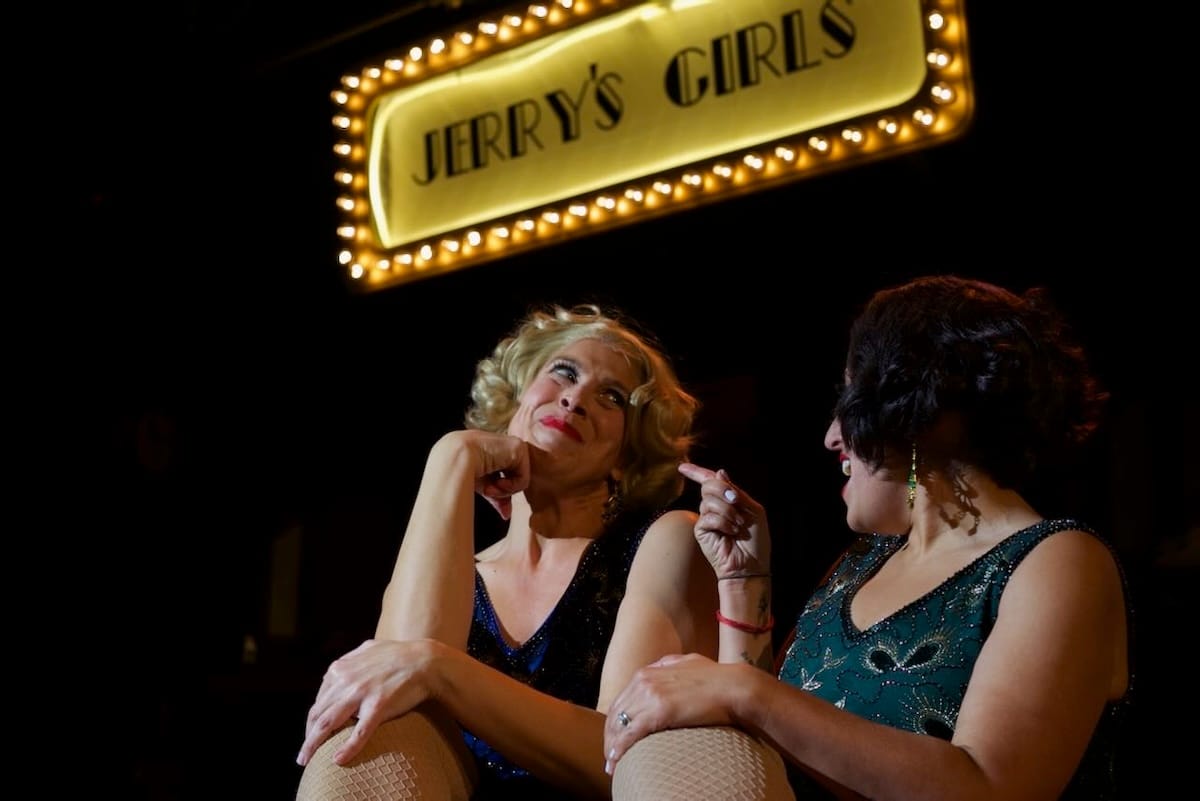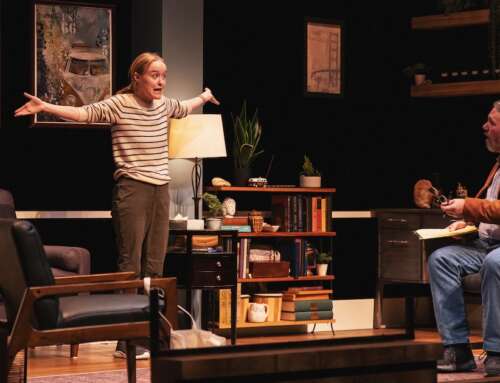Veritas Productions delivers a stylish overview of Jerry Herman’s classic show tunes.
Musical revues, song-and-dance showcases built around a composer’s work rather than a traditional plot, live and die on momentum. With no story to drive the evening forward, everything depends on the performers’ charisma, the staging’s imagination and how well the songs connect with the audience.
In Veritas Productions & Theatre Arts’ staging of Jerry’s Girls, running through November 23 at the Mizel Arts and Culture Center’s Pluss Theatre, those strengths come in varying degrees.
Directed by Katie Reid Milazzo, the show strings together more than 30 songs by Jerry Herman, the Broadway legend behind Hello, Dolly!, Mame and La Cage aux Folles, known for his buoyant melodies and unapologetic optimism. Three performers, Nancy Evans Begley, Ali Chung and Dana Hart Wright, rotate through solos, duets and ensemble numbers in a fully sung-through format that moves briskly from one classic Herman tune to the next.
The production marks Veritas’ first independently mounted show, arriving later than expected after Begley’s emergency appendectomy postponed its planned September debut. What’s now onstage, however, is delivered with clear care: a well-coordinated design palette, confident vocal work and a live band that brings warmth to Herman’s mid-century Broadway sound.
Whether that’s enough depends largely on a viewer’s familiarity with, and appetite for, two acts of Herman’s brassy musical style. For audiences new to Herman’s music, such as myself except for songs from La Cage, the revue’s charm feels more steady than surprising.

Nancy Evans Begley, left, and Ali Chung in ‘Jerry’s Girls’ | Photo: Noah Begley – Paper & Light Photography
A cohesive visual world
The evening is set in the performers’ backstage dressing room, an environment that scenic designer Andrew S. Bates and lighting designer Brett Maughan render with theatrical polish. Light-rimmed mirrors, costume pieces are spread about the space and posters from Herman’s greatest hits establish the setting without overcomplicating it, while a glowing “Jerry’s Girls” marquee overhead provides a consistent visual anchor.
The space feels lived-in, flexible and unobtrusive, which is well-suited to a show that needs to pivot rapidly between more than 30 songs.
Color, meanwhile, drives the production’s design logic. Costume designer Cole Emarine assigns each performer a signature hue — Begley in red, Chung in blue and Wright in green — and uses those colors as a throughline across base costumes and flashier add-ons. The effect is both visually tidy and stylistically playful, giving the trio identity without forcing character arcs onto a revue that isn’t built to support them.
Perhaps the most impactful design choice, though, is the decision to use live music rather than recorded tracks. Music director Aldo Allgoode (on keyboard) and bassist Johnny Torres turn Herman’s arrangements into something vibrant and present. Their musicianship and good humor, particularly during a brief comedic bit leading into “Hello, Dolly!” keeps the show moving even when the staging settles into familiar patterns.
With no dialogue and no structural breaks between songs, the performers must carry the entire evening through presence alone. All three are capable vocalists, but Ali Chung consistently lifts the energy in the room.
Chung’s comedic instincts are razor-sharp, and numbers like “Wherever He Ain’t,” “Look What Happened to Mabel” and the crowd-pleasing “Gooch’s Song” give her ample room to shine. She’s the performer who most successfully bridges Herman’s vintage style with a contemporary sensibility.
Begley brings warmth and control to her material, especially in “Just Leave Everything to Me” and a grounded, sincere “If He Walked Into My Life.” Wright’s voice is lovely, and she finds genuine poignancy in “Shalom” and “Time Heals Everything,” though she occasionally seemed tentative in the performance I attended, breaking the illusion by checking in with the audience rather than staying anchored in the show’s emotional world.
The clearest taste of what this revue could be at its best arrives with “Tap Your Troubles Away,” a buoyant duet for Begley and Chung featuring light tap choreography by Rebecca Scott Dean. It’s fleet, charming and theatrical and an excellent reminder that these songs can transcend nostalgia when staging and performance spark together.
A polished tribute that never quite finds its argument
For all its strengths, Jerry’s Girls ultimately struggles to advocate for itself to newcomers. Herman’s melodies, while undeniably tuneful, can blur together when delivered at this pace and without narrative grounding. The revue provides no context about Herman’s life, collaborators, or impact and offers little connective tissue beyond the songs themselves.
For Broadway fans already devoted to his output, the evening may feel like a warm, glittering celebration. But for those encountering his work for the first time, the effect can be distancing rather than illuminating.
At around an hour and 45 minutes of material spread across two acts, the show is not unusually long, yet the sheer volume of similar-sounding mid-century numbers can create a sense of sameness. The performers and musicians do everything they can to bring variety to the evening, but the revue’s structure leaves limited room for reinvention.
Still, there’s no denying the production’s polish. The vocals are consistently strong, the live band elevates every number, and the design aesthetics are thoughtfully cohesive. As an act of homage, Jerry’s Girls is sincere and well-executed. As an introduction to Herman for younger or less Broadway-initiated audiences, it may be a harder sell.
That challenge is compounded by the staging itself, which settles into a predictable rhythm early on. Milazzo’s dressing-room concept is appealing, but the blocking and transitions rarely shift the visual or emotional temperature of the room. Song after song unfolds in a similar pattern, enter, sing, exit or reset, so the production mirrors the uniformity of the score rather than cutting against it. The result is an evening that’s undeniably well produced but increasingly static.
Jerry’s Girls shines brightest when its performers lean into personality and playfulness. But for most of its runtime, the show is a bit too one-note. Granted, the note it plays is a lovely one, but it just never quite changes.
A Colorado-based arts reporter originally from Mineola, Texas, who writes about the changing world of theater and culture, with a focus on the financial realities of art production, emerging forms and arts leadership. He’s the Managing Editor of Bucket List Community Cafe, a contributor to Denver Westword and Estes Valley Voice, resident storyteller for the Bonfils-Stanton Foundation and co-host of the OnStage Colorado Podcast. He holds an MBA and an MA in Theatre & Performance Studies from CU Boulder, and his reporting and reviews combine business and artistic expertise.










Leave A Comment